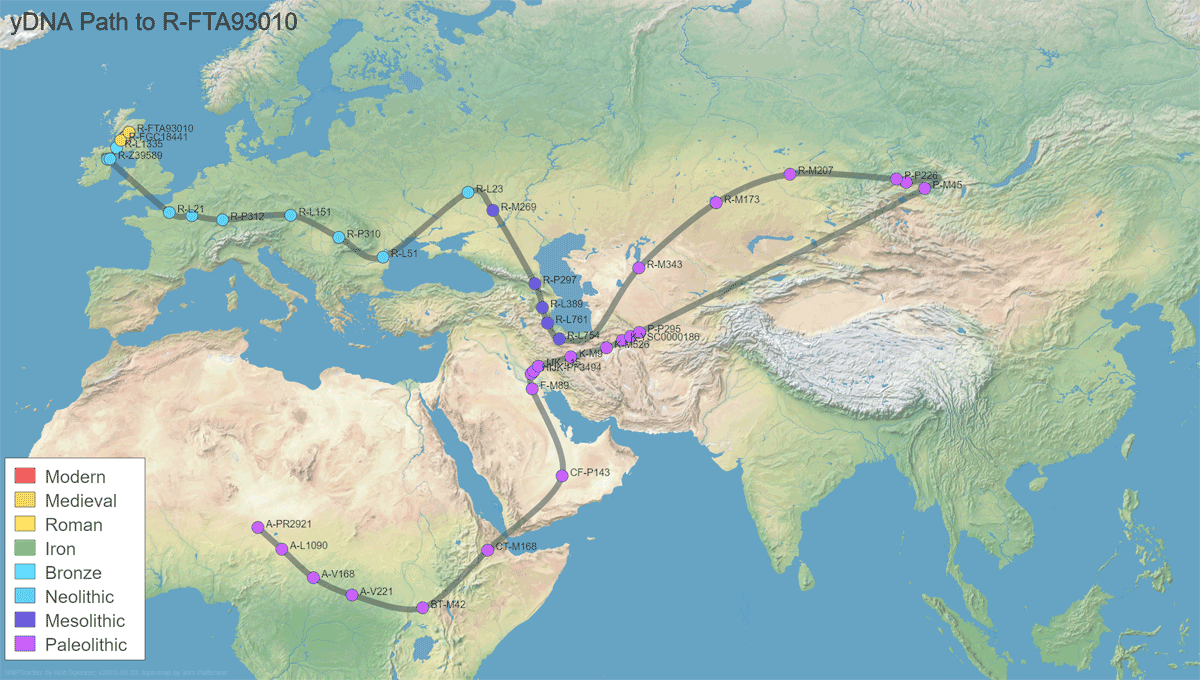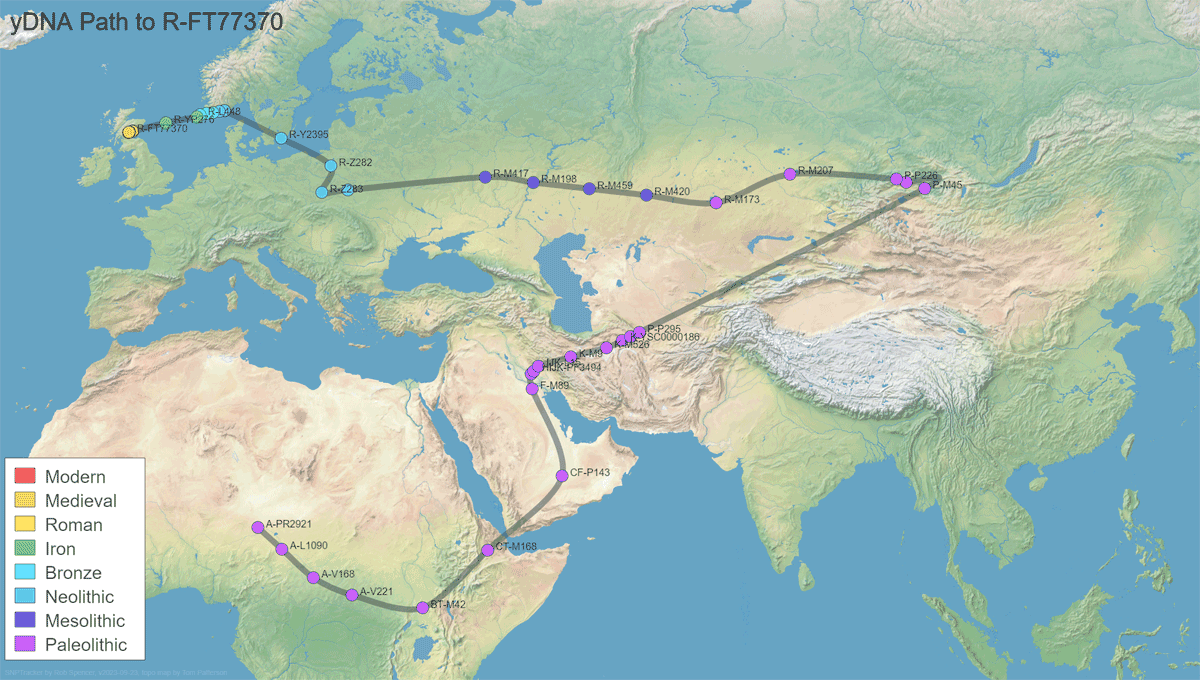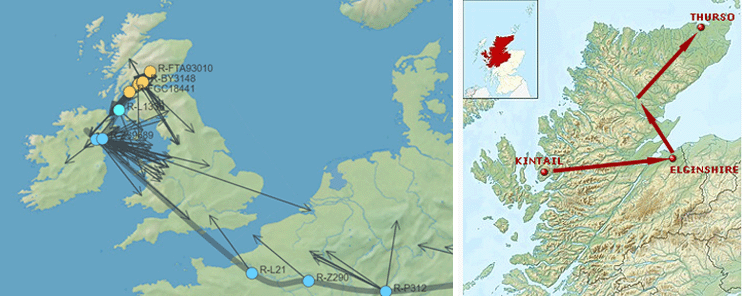The Genetic Genealogy of the Macdonalds of Sutherland
About Y-DNA testing
Genetic genealogy is like creating a family tree, but with a twist. Rather than just using traditional methods looking at old records, we also use DNA test results. These tests help us understand how people are related to each other based on their biological connections.
With Y-chromosomal DNA (Y-DNA), this is a special type of DNA found only in males. It’s like a genetic map that tells us about a person’s paternal lineage—meaning their family line on their father’s side. The Y chromosome is passed down from fathers to their sons, and it usually stays pretty much the same over many generations. However, there can be tiny changes in the DNA that we can trace.
When we do Y-DNA tests, we’re looking at relationships along a strict male line. These tests help us figure out things like archaeological cultures and the migration paths our ancestors took. It’s like following a trail left by our forefathers. And based on this Y-DNA information, we can identify a person’s haplogroup—a genetic family group. For example, the Macdonald of Sutherland family belongs to the R1b haplogroup, and more specifically, the R-FTA93010 subclade of the R1b haplogroup.
How this Macdonald branch came to settle in Scotland

Clan Donald is one of the oldest and most famous Highland clans. Their roots stretch back to ancient times, even before the 6th century AD. Let’s break it down:
1. Celtic Heritage: The clan’s Celtic heritage goes way back. Imagine a time long before modern records—back to when great clans existed in what we now call Ireland. Some notable figures include:
• Conn of the 100 Battles
• Cairfre Raida, who founded Dal Raida in Antrim, Ireland
• Colla Uathais
2. Viking Roots: Clan Donald also has Viking blood. Around the 7th century, two Viking ancestors played a role:
• Ingiald “Ill-Ruler”
• Olaf “Tree-Hewer” from Sweden and Norway
3. Somerled: Now fast-forward to the 12th century. Somerled MacGillebride MacGilladamnan was a pivotal figure. He brought together all these ancient bloodlines and founded Clann Domhnaill. His ancestors were considered the leaders of the ancient Conn race, and they were the rightful heirs to the kings of the Dalriadic Scots.
In 2004, the Clan Donald Genetic Project identified a 25-marker signature that helps trace descendants of Somerled. These descendants include MacDonalds, MacDougalls, and MacAllisters, including their Clan Chiefs. Somerled’s legacy is impressive—he and his kin controlled much of the west coast of Scotland and the Hebrides for over 500 years.
Comparing the DNA migration path of the Macdonalds of Sutherland (R1b) with that of Somerled’s ancestors (R1a)
For this study, we completed an analysis of the Y-DNA of one of the great grandsons of Alexander Sinclair Macdonald. We confirmed that this volunteer was genetically related to all other cousins descended from Alexander who completed basic autosomal tests with Ancestry in recent years.
Above: Ancestral Migration for Alexander Sinclair Macdonald (Haplogroup R1b- FTA93010)
Split after M173 from R1a line below East of Caspian Sea (now Kazakhstan).
Alexander’s ancestors arrive in Scotland in Bronze Age (2,100-750 BCE)
Maps created with ScaledInnovatiion tools.

Above: Ancestral Migration for Somerled (Haplogroup: R1a- FT77070). The migrations from Scandinavia started in Viking times around 800 AD. Somerled came later around 1153 AD. Though patrilinearly Norse, Somerled is also of Irish Celtic descent.
Settling in Scotland: The Macdonalds of Sutherland branch

British Isles some 4,500 years ago.
As the maps above showed us, the ancestors of this Macdonald branch split from the R1a branch (Somerled's group) in the area now known as Kazakhstan. This happened about 23,000 years ago! Migrating westwards, they cross from the area of the Beaker People in today's Northern France about 4,500 years ago to the British Isles (probably via Ireland).
What remains unclear is what led one of more Macdonalds to settle on the north coast of Mainland Scotland in Sutherland (Now Caithness and Sutherland). These were the rugged and windswept crofting lands of the Sinclair, Sutherland and Munro clans.

This Y-DNA project’s next priority will be to figure out where these Macdonalds came from before they moved up to Sutherland.
Early comparisons to other DNA matches suggest one scenario that they lived for some time in Elginshire (later Morayshire) and before that in the Kintail area near the strongholds of Glengarry on the mainland, east of the Isle of Skye. So far, there are no matches found to the Skye or Inner Hebridean Macdonalds.
This is all however still unconfirmed! We will update this information as the project progresses.

